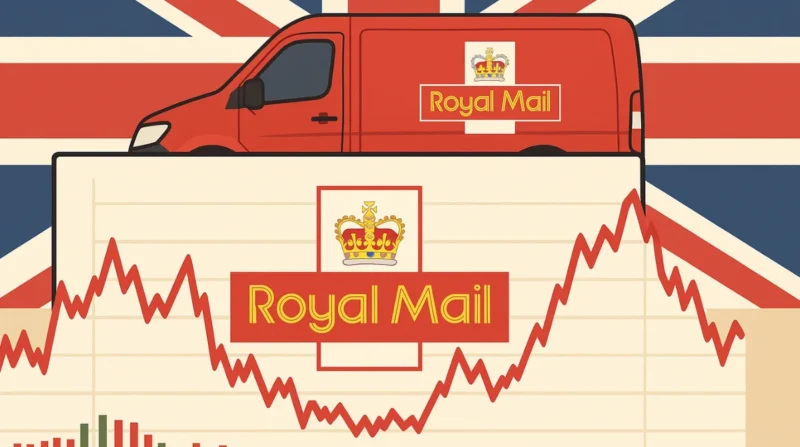Table of Contents
Royal Mail, a cornerstone of British postal services since 1516, has undergone significant transformations over the years. From its privatization in 2013 to recent ownership changes, understanding its share price movements is crucial for investors. This guide explores the key factors affecting the Royal Mail share price, recent changes in the company, and what investors can expect in the future.
A Brief History of Royal Mail
Royal Mail is one of the oldest postal services in the world, started more than 500 years ago. It has played a major role in helping people across the UK send and receive letters and packages. For most of its history, it was owned and run by the UK government.
But in 2013, the government decided to privatize it. This means they sold it to private investors instead of running it as a public service. Royal Mail became a publicly traded company, which means people could buy and sell its shares on the London Stock Exchange (a big marketplace for company shares in the UK).
When it first became public, Royal Mail’s share price was set at 330 pence (or 330p) per share. But very quickly, the price jumped to over 600p. This big jump made many people believe that the government sold the company too cheaply, and they could have gotten more money if they had priced the shares higher in the beginning. That’s why the privatization got a lot of criticism, it looked like investors made quick profits, but the public may have lost out.
Share Price Performance Over the Years
After Royal Mail became a public company and people started buying and selling its shares on the stock market, the price of its shares kept going up and down this is called volatility. Several problems affected how investors felt about the company and whether they wanted to keep or sell its shares.
One big reason was that fewer people were sending letters, thanks to emails and texting so the company made less money from mail services. At the same time, parcel delivery (packages) became more competitive, with companies like Amazon, DPD, and Hermes doing a better job in many areas.
Also, Royal Mail had internal problems, like delays in updating their systems and plans to modernize. In 2019, the share price dropped by 14% in one day because investors heard there were delays in the company’s improvement plans and possible strikes by workers, which could disrupt services.
The Křetínský Takeover
In 2024, something historic happened. A billionaire from the Czech Republic named Daniel Křetínský bought Royal Mail’s parent company, International Distribution Services (IDS), for £3.6 billion. This was a big deal because it meant that Royal Mail was no longer owned by UK investors, for the first time in over 500 years, it came under foreign ownership.
However, Křetínský made some important promises. He said he would:
- Keep the Royal Mail brand name
- Continue offering services across the UK, even to remote places (this is called the Universal Service Obligation)
- Invest money to modernize and improve operations, making the company more efficient and competitive
This takeover gave hope to some investors that Royal Mail might become stronger in the future with better leadership and investment.
Challenges Faced by Royal Mail
Royal Mail has faced several big problems over the years, and these issues have affected how well the company performs and how much its shares are worth. Here’s a look at the main challenges:
- Declining Letter Volumes: People aren’t sending as many letters anymore. Emails, texts, and social media have become the main ways people communicate. Because of this, Royal Mail is delivering fewer letters and making less money from this service. This has had a big impact on their earnings.
- Competition in Parcel Delivery: Even though people buy more things online and send more packages, Royal Mail has faced a lot of competition from other delivery companies like Amazon, DPD, and Hermes. These companies are faster and cheaper, which has caused Royal Mail to lose customers. This has hurt their business and affected their share price.
- Operational Struggles: Royal Mail has had trouble improving how it works. The company has been slow to update its systems and modernize its services. On top of that, there have been strikes (where workers stop working) and disagreements with employees, which led to delays and problems in the delivery process. These struggles have made it harder for Royal Mail to improve performance and keep customers happy.
Because of these problems, Royal Mail has struggled to grow and keep investors confident, which is why its share price has been unstable over the years.
Financial Performance
Royal Mail’s money situation shows just how tough things have been for the company. In the 2023/24 financial year, their total revenue (money earned) was a big number: £12.68 billion. But after paying for all the running costs, the company only made a small profit of £26 million.
That’s a very small amount compared to how much money came in, which shows that costs are very high. A big part of those costs came from overtime pay and hiring temporary workers, especially when workers went on strike or didn’t show up because of internal problems. This made it harder for the company to make good profits.
Strategic Initiatives
To fix some of the challenges it’s facing and improve in the future, Royal Mail is making some important changes:
- Automation: Royal Mail is investing in automated machines that can sort parcels (packages) more quickly and accurately. These machines help save time, reduce mistakes, and cut down on the need for extra workers. In the long run, this helps lower costs and makes the whole process more efficient.
- Sustainability: The company is now using electric delivery vans instead of traditional gas-powered ones. These electric vans are better for the environment because they don’t pollute the air. Plus, they save money on fuel costs, which is important since fuel prices can be expensive. Over time, this will help lower operating costs for Royal Mail.
- Global Expansion: Royal Mail is also looking to grow internationally. They’ve been buying companies in other countries, such as Rosenau Transport, a delivery company in Canada. By doing this, Royal Mail can start offering its services outside of the UK, opening up new opportunities and sources of income. This helps the company become more competitive in the global market.
These initiatives show that Royal Mail is not just reacting to problems but also trying to adapt and improve in ways that will help them stay successful in the future.
Analyst Perspectives
Analysts are professionals who study companies and give advice to investors about whether to buy or sell shares. Here’s what two major analysts say:
- Citigroup: They say investors should buy Royal Mail shares because the company might improve its operations and become more efficient. They think the share price could go up to £3.25, which means there’s room for growth.
- The Motley Fool: They also believe Royal Mail might be undervalued, meaning the current share price is lower than what the company is really worth. They believe that, with better management and global growth, the company could do well in the future.
Royal Mail Jobs
Royal Mail is one of the largest employers in the UK, with thousands of workers across the country. The company offers a wide range of job opportunities, from delivery roles to office-based positions and technical careers.
Common job roles at Royal Mail include:
- Postmen and Postwomen: Delivering letters and parcels to homes and businesses.
- Sorting Centre Workers: Helping to organize and sort mail at regional centres.
- Drivers: Driving vans and trucks to transport packages locally and nationally.
- Customer Service: Assisting customers with queries, both online and in person.
- IT and Operations Roles: Working on Royal Mail’s digital systems and process improvements.
Royal Mail jobs are known for offering stable employment, competitive pay, and benefits like paid holidays and pensions. The company also focuses on diversity, inclusion, and career development, with training programs available for many roles.
How to Apply?
You can find Royal Mail jobs and apply directly on the Royal Mail Careers website. The site allows you to filter roles by location, job type, and experience level. Whether you’re starting out or looking for a career change, Royal Mail jobs can be a solid choice especially if you want to be part of a long-standing British institution.
Future Outlook
Looking ahead, the future performance of Royal Mail will depend on a few key factors:
- Successful Integration Post-Takeover: Since Daniel Křetínský (the Czech billionaire) took over Royal Mail’s parent company, EP Group (in 2024), how well this new management team is able to integrate and improve the company’s operations is really important. If they manage to make Royal Mail work better, revitalize the services, and solve past problems, the company’s future could be much brighter.
- Adapting to Market Dynamics: The world of parcel delivery is very competitive, and consumer preferences are always changing. Royal Mail will need to stay flexible and adapt to these changes. This could mean competing with other delivery services like Amazon and DPD, and also finding new ways to serve customers better as their needs evolve.
- Operational Efficiency: Royal Mail’s success will also depend on how well they implement the automation (machines that sort parcels more quickly) and sustainability efforts (like electric delivery vans). These changes are meant to lower costs and improve the quality of service, which could help Royal Mail become more efficient and better at competing.
These factors will play a big role in whether Royal Mail can bounce back from its current struggles and become a stronger company in the future.
Conclusion
Royal Mail has had a long and eventful journey. It started as a government-owned service, but in recent years it became a private company, and in 2024, it was even taken over by a foreign owner for the first time in over 500 years.
Even though Royal Mail is still facing problems like fewer letters being sent, more competition, and some internal struggles it is also trying to improve. The company is making smart investments in things like automation, eco-friendly delivery vans, and global expansion to help turn things around.
For investors (people who buy shares in the company), it’s important to keep an eye on how Royal Mail is doing, especially how well the new owner runs the business and how the company adjusts to the fast-changing delivery market. This will help them decide if investing in Royal Mail’s shares is a good move.









